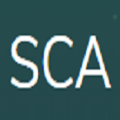In this letter, we investigate an unmanned aerial vehicle (UAV) communication system, where an intelligent reflecting surface (IRS) is deployed to assist in the transmission from a ground node (GN) to the UAV in the presence of a jammer. We aim to maximize the average rate of the UAV communication by jointly optimizing the GN's transmit power, the IRS's passive beamforming and the UAV's trajectory. However, the formulated problem is difficult to solve due to the non-convex objective function and the coupled optimization variables. Thus, to tackle it, we propose an alternating optimization (AO) based algorithm by exploiting the successive convex approximation (SCA) and semidefinite relaxation (SDR) techniques. Simulation results show that the proposed algorithm can significantly improve the average rate compared with the benchmark algorithms. Moreover, it also shows that when the jamming power is large and the number of IRS elements is relatively small, deploying the IRS near the jammer outperforms deploying it near the GN, and vice versa.
翻译:在这封信中,我们调查了无人驾驶飞行器通信系统(无人驾驶飞行器),在该系统中部署了智能反射表面(IRS),以协助在出现干扰器的情况下从地面节点(GN)向无人驾驶飞行器传输。我们的目标是通过联合优化GN的传输力、IRS的被动波束成形和无人驾驶飞行器的轨迹,最大限度地提高无人驾驶飞行器通信的平均速率。然而,由于非阴道目标功能和组合优化变量,设计的问题难以解决。因此,为了解决这一问题,我们建议采用基于交替优化的算法,利用连续的 convex近似(SCA)和半确定性放松(SDR)技术。模拟结果表明,拟议的算法可以大大改善与基准算法相比的平均速率。此外,它还表明,当干扰力很大,IRS元素数量相对小时,在干扰器外围部署IRS时,部署IRS的频率相对小,反之,在GNG附近部署IRS时,反之。





